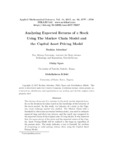Analyzing Expected Returns of a Stock Using The Markov Chain Model and the Capital Asset Pricing Model
| dc.contributor.author | Adesokan, Ibrahim | |
| dc.contributor.author | Ngare, Philip | |
| dc.contributor.author | Kilishi, Abdulhakeem | |
| dc.date.accessioned | 2019-05-08T06:15:10Z | |
| dc.date.available | 2019-05-08T06:15:10Z | |
| dc.date.issued | 2017 | |
| dc.identifier.issn | 2777 - 2788 | |
| dc.identifier.uri | http://ir.mksu.ac.ke/handle/123456780/4404 | |
| dc.description.abstract | The chances of success of an investor in the stock market depends heavily on the decisions he takes based on his knowledge of the behavior of the stock market. In this study, the behavior of a stock on the Nigerian stock exchange market was studied. The Markov Chain with a threshold to determine movement between states, was used to estimate expected long and short-run returns, and the result was compared to the expected return of the Capital Asset Pricing Model. It was observed that the mean return of the stock and the expected return of the Capital Asset Pricing Model will be realized in the long-run regardless of the present state. The study indicates a way to forestall the problem of overpricing or under-pricing returns when using the Capital Asset Pricing Model. | en_US |
| dc.language.iso | en_US | en_US |
| dc.subject | Stock market | en_US |
| dc.subject | Markov Chain | en_US |
| dc.subject | Capital Asset Pricing Model | en_US |
| dc.subject | Expected return | en_US |
| dc.subject | Limiting distribution | en_US |
| dc.subject | Steady-state probability | en_US |
| dc.title | Analyzing Expected Returns of a Stock Using The Markov Chain Model and the Capital Asset Pricing Model | en_US |
| dc.type | Article | en_US |
Files in this item
This item appears in the following Collection(s)
-
School of Pure and Applied Sciences [259]
Scholarly Articles by Faculty & Students in the School of Pure and Applied Sciences

